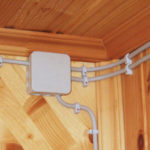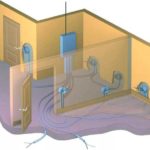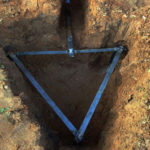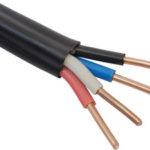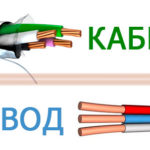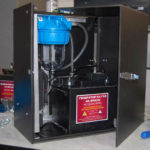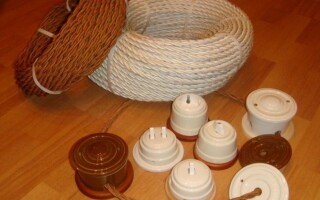The interior, which was in the homes of our grandparents, remains popular, especially in cottages and bathhouses made of wood. Due to the fact that buildings made of this building material can burst into flames from just one spark, according to the rules of the electrical installation device (PUE), it is allowed to do open wiring.
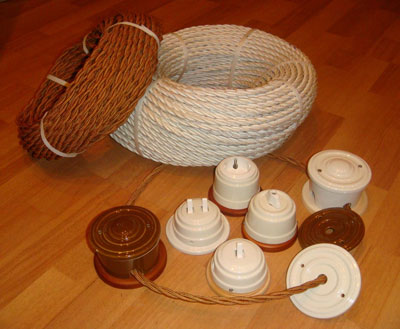
But one problem with it is the modern look, which would disrupt the cozy vintage ambiance. The way out is retro wiring.
Contents
Why do people choose retro wiring over interior wiring?
There are several reasons why people choose exterior antique wiring over interior wiring:
- For aesthetic reasons.
- For safety reasons. According to the rules for electrical installation (PUE), concealed wiring in wooden walls is allowed, but only if it will be in a pipe made of metal or covered with a non-flammable plaster layer of 1 cm.
The problem is that there is a seasonal shrinkage of the wooden house, when during the rains and even just in humid air, it becomes a little higher, and when it is dry, on the contrary, lower. The change can be as much as 5 per floor, which is very serious. It's better to do open retro wiring. It is both easier, more practical, and more beautiful.
Such retro wiring in a wooden house is relatively safe. But only if it will be located at a distance of at least 1.2 cm from the walls susceptible to fire and have a support in the form of insulators made of metal, ceramic, porcelain or any other non-combustible materials.
As for the outlets / switches, junction boxes for outdoor retro wiring, you should buy metal, ceramic or porcelain. They will look best. But you can also buy the usual plastic ones.
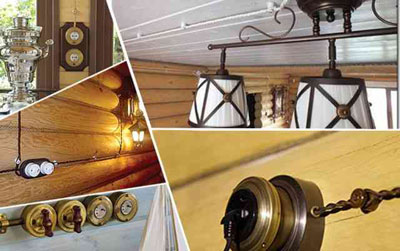
What is needed for exterior retro wiring?
A list of what is needed for exterior retro style wiring:
- Twisted cable that fits the retro style.
- Insulators.
- Outlets/switches, junction boxes. These can be made of any material, but the back is made of non-combustible material.
Twisted Cable
A twisted cable is a conductor that is surrounded by polyvinyl chloride (PVC) insulation as well as a single layer of textile, usually technical silk. It differs from the usual in that it is impregnated with flame retardant - a substance that reduces flammability.
Types of twisted cable:
- consisting of 2 conductors;
- consisting of 3 conductors;
- consisting of 4 conductors.
For retro-wire, a twisted cable consisting of 3 conductors is suitable: the first will be the phase, the second will be the neutral, i.e. zero, and the third will be the protection.
This cable can be divided into groups not only according to the number of conductors, but also according to the cross-section:
- 1,5 к;
- 2.5 sq. mm.
Twisted cable with a cross section of 2.5 sq. mm will be required for the outlets. One line can handle from 2 to 4 devices, if their total power does not exceed 3 kW, and the total current is 16A. And for lighting - cross-section of 1.5 kV. mm. Maximum load: power of 2 kW amperage of 10A. This is enough for twenty light bulbs (100W). And if you plan to screw in frugal or LED, even more.
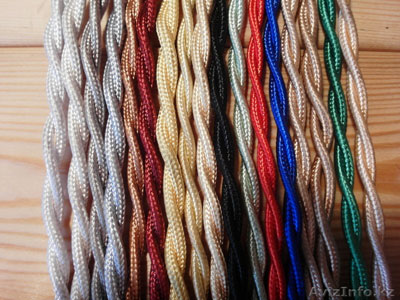
The most popular manufacturers of twisted cable
The most popular manufacturers of twisted cable are:
- Italian companies: Gambarelli, Gordon Dor, Fontiny Garby. The first of them have the best twisted cable, it is rigid and easily put on insulators. They cost very expensive, from $3 to $5 for one meter.
- The German company Replikata. Almost exactly the same quality.
- Companies in Russia: Gusev, Gemini, Electro. The price is much lower, no more than $2 per meter.
European products have a higher quality than domestic ones.
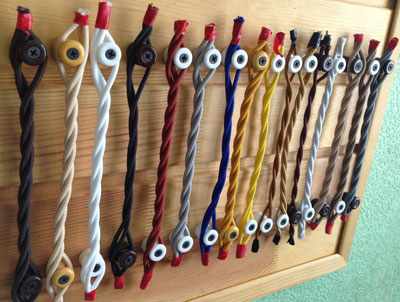
Insulators
Insulators are rollers made of ceramic. Their size: diameter - 18 to 22 mm, height - 18 to 24 mm. The top is narrow and wide. The first is more convenient for a twisted cable of 2 conductors, the second is for a twisted cable of 3 conductors.
To install the insulators you will need fasteners - self-tapping screws. Their length should be such that they sink into the wooden wall by two-thirds. There are insulators that already come with fasteners. This is very convenient, since you do not need to waste time looking for them.
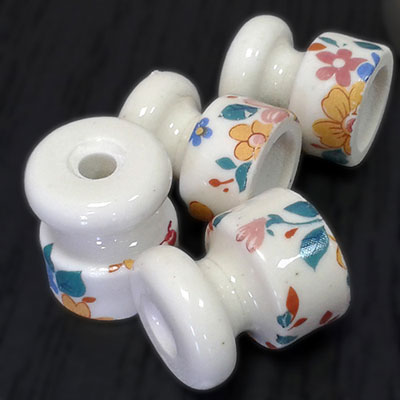
Outlets/switches and junction boxes
As noted above, give preference to outlets/switches and junction boxes made of metal, ceramic and porcelain. Devices made of plastic will look a little silly against the wood and vintage.

Assembling retro style exterior wiring
When assembling exterior retro style wiring, not only remember, but also follow the general rules:
- Any branch circuit, whatever it may be, is done in a junction box.
- From the junction box, the wire goes down.
- The distance between the outlet/switch and the door jamb/window jamb should not be less than 10 cm.
- The interval between the socket / switch and the heating system, plumbing, gas piping should not be less than half a meter.
The assembly of the external wiring itself begins with fixing the insulators. The distance between them - from 30 to 80 cm. In the case of a log house, insulators should be installed one by one.
Sockets / switches are placed at a distance of half a meter from the last insulator. You can and a little less, but do not overdo it. Twisted cable can sag and you will have to do double work - shorten it and connect it again.
Now you know how to install retro-style wiring. Before you do the job, look at pictures on the Internet. That way you'll know what will look best.
This picture shows how far apart the insulators should be on the bends. Although this picture is from an old book, the information is still valid today.
How to use retro wiring in a wooden house to create a true vintage interior?
In order to properly use retro wiring in a wooden house to create a true vintage interior, you will need to be a little more diligent. The fact is that such wiring will be at everyone and always in sight and any, even the slightest, error will be noticeable.
Since you will be doing retro style wiring not in an apartment, but in a wooden house, be prepared for the fact that after removing improperly installed fasteners on the wall will appear dents. It is not easy to hide them.
Therefore, before you start the work, take a sheet of paper and a pencil and at least schematically draw what you want to do. Transfer the drawing on the wall, you can use the same pencil, but carefully, so as not to damage the surface.
If you doubt that the outlets/switches and junction boxes are where you want them, check them. Take regular, or better, masking tape and attach the wire to the ceiling. This way you can understand what the end result will be and, if there is a need, make changes.
Separately, the following should be mentioned. If the wooden house is not yet fully settled, the twisted cable should be stretched. If it has matured or is built of laminated timber, the wire, on the contrary, does not need to be stretched. It is very important to find that golden mean, when the cable is not heavily and not weakly screwed on the insulators.
Related articles:
